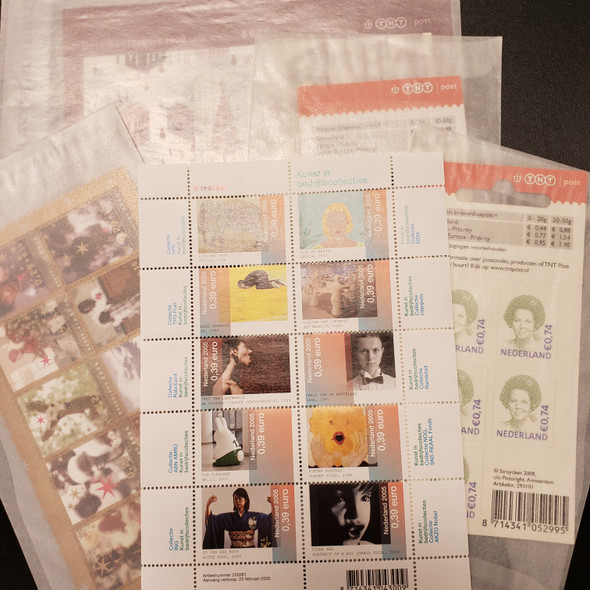NETHERLANDS (2023)- FLORAL GREETINGS- STAMP SHEET & POSTCARDS IN BOOKLET
- SKU:
- 0523_NET_12
Description
With the issue of the A floral greeting booklet, PostNL is responding to consumer demand for matching cards and stamps. This is the first time PostNL has published a product like this. The six greeting cards and six personalised stamps feature images of flowers from drawings and watercolours exhibited in the Rijksmuseum Amsterdam. The design of A floral greeting was created by designer and artist Joëlle Wehkamp from Nederhorst den Berg. The six personal stamps will be marked ‘Nederland 1’, the denomination for items weighing up to 20g destined for the Netherlands.
The A floral greeting booklet features six stamps in six designs within the fixed frame of the personal stamps. The design was created by designer and artist Joëlle Wehkamp from Nederhorst den Berg. Each stamp features a large free-standing drawing of a flower with stem and leaves against a plain background with a different colour for each flower. Each drawing is framed by a narrow border with a pattern of squares in different colours. The edges of the sheet also feature flowers. The stamp sheet is part of a booklet that contains the greeting cards. The cards feature the same illustrations as the stamps, but in a larger format. The A floral greeting booklet contains an explanation of Joëlle Wehkamp's methods and illustrations. A tear-off perforation allows the greeting cards to be detached while leaving the booklet intact.
The font used for the denomination 1 and Nederland was designed in 2018 by type designer Martin Majoor from Arnhem. The remaining typography in the A floral greetings booklet uses the Georgia serif font, designed in 1993 by Matthew Carter (Carter & Cone Type Inc., Cambridge, Massachusetts) and adapted for digital use in 1996 by Tom Rickner (Monotype Imaging Inc., Woburn, Massachusetts).
The A floral greeting greeting cards and stamps feature six flowers: lupine, geranium, marigold, Persian lily, wood anemone and French rose. The lupine is a genus of flowering plants in the pea family that includes 200 species. In north-western Europe, only the perennial lupine occurs in the wild. Most lupines are purple, white or pink, although they occasionally come in yellow. The geranium is a perennial plant also known in Dutch as ooievaarsbek (stork bill) or tuingeranium (garden geranium). These flowers bloom every year when planted outdoors. The blooms come in all colours except yellow and orange. The flowers often have delicate markings. The marigold (also known as Afrikaantje or African marigold) is native to Central America and was brought to Europe by the Spanish. Blooms can be creamy white, greenish yellow, yellow, orange, red and mahogany or variants thereof. The Persian lily is a bulbous perennial, with tall, upright stems and large clusters of bell-shaped flowers. The colour ranges from deep dark purple to almost ivory white. The wood anemone is one of the first plants to bloom in spring and is often found in deciduous forests and on estates. The white flowers can cover the ground, sometimes making it look like there is still some snow left in the forest. And finally, the French rose has been cultivated for centuries and is a parent of many contemporary garden roses. It comes in several varieties and cultivars, with colours ranging from deep red and pink to light-pink and deep purple.
Just like the booklet, the design of the stamps and the greeting cards in A floral greeting was created by designer and artist Joëlle Wehkamp from Nederhorst den Berg. For her design, she used details of drawings and watercolours from Rijksstudio, the digital archive of the Rijksmuseum Amsterdam. Wehkamp was introduced to this archive when she participated in the 2016 Rijksstudio Award, a biennial art and design award. ‘My entry consisted of all the letters of the alphabet, created from collages of fragments of artworks from the Rijks. I did not win, but two years later, my design was nevertheless used for all kinds of products sold as Art Alphabet by the Rijksmuseum. From then on, I have always reused details of existing artworks for my work, in addition to the prints, drawings, paintings and illustrations I create myself, of course.










